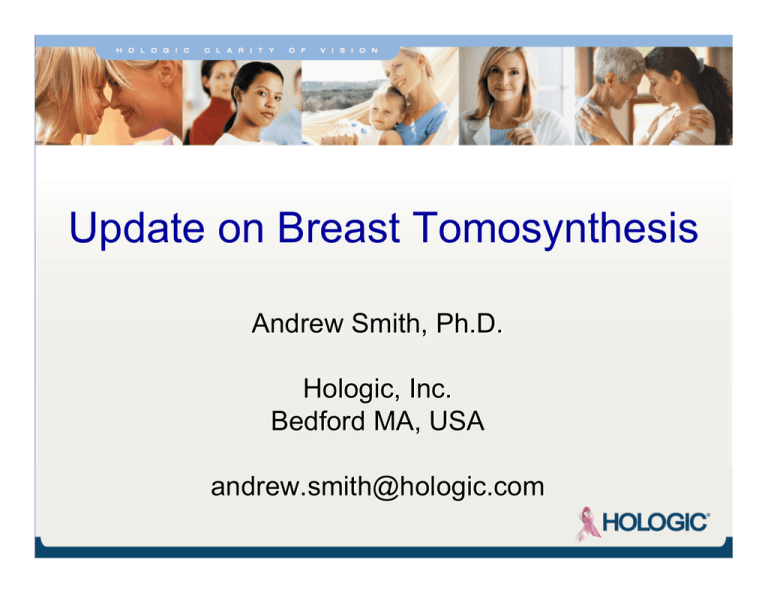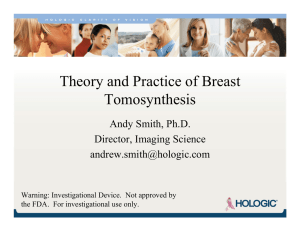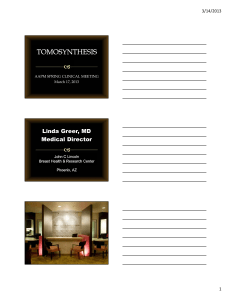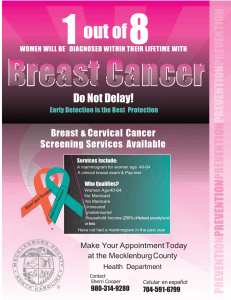Update on Breast Tomosynthesis Andrew Smith, Ph.D. Hologic, Inc. Bedford MA, USA
advertisement

Update on Breast Tomosynthesis Andrew Smith, Ph.D. Hologic, Inc. Bedford MA, USA andrew.smith@hologic.com What is Breast Tomosynthesis? A method of imaging the breast in three dimensions (3D) Image slices are 1 mm thick Image slices high resolution: like mammograms Why do tomosynthesis? Tissue overlap hides pathologies Tissue overlap mimics pathologies 3D improves visibility Visible in 3D Hidden in 2D Tomosynthesis acquisition X-ray tube swings during tomo Stationary breast platform Tomosynthesis 3D Acquisition Clinical Benefits In multi-center clinical studies, conventional FFDM plus tomosynthesis has been shown to: – Increase sensitivity Screening trial required to validate statistical significance; however, data from Reader studies suggest potential for 15% increase in sensitivity – Reduce recalls by 29% Potential to eliminate ~1M recalls for every 30M women screened Pooled ROC Curves Radiologist Variability with 2D and 2D+3D 2D+3D 2D Decision to Recall, non-cancer cases (BIRADS 0) Agreed on recall decision Kappa 2D 2D+3D 70.9% 78.7% 0.413 0.530 Kappa differences statistically significant How Use Tomosynthesis? Wherever you now use 2D, use 2D+3D 3D gives additional information, especially useful for mass detection “Averaged” ROC Curves All cases Calcs only No calcs - Improvement from 3D due to masses - It does not mean 3D no good for calcs, just no better than 2D Why 2D+3D, and not just 3D? 3D most useful for masses, removing superimposed parenchyma 2D is very useful: During transition to 3D, 2D is gold standard 2D speeds up calcification assessment 2D useful for comparison to 2D priors CAD ~ only available on 2D initially 2D needed for reimbursement Equipment can facilitate acquiring both 2D and 3D Images are co-registered Why both CC and MLO? RSNA 2006 Breast Tomosynthesis: One View or Two? Rafferty, Niklason, Jameson-Meehan. 34 Lesions, imaged both CC and MLO tomo. 65% seen equally on both 12% more visible on MLO 15% more visible on CC 9% only seen on CC (all malignant). Acquisition 3D+2D Tomosynthesis Commercial Status -Some breast tomosynthesis systems are cleared for sale in the European Community and awaiting FDA clearance in the U.S. - Others are in clinical trials. Recall Reduction – Superimposed Tissue (Case 1) Recall Reduction – Superimposed Tissue (Case 2) Invasive Ductal Carcinoma (Case 3) Case 3 Region of Interest FFDM TOMO Infiltrating Ductal Adenocarcinoma (Case 4) Case 4 Region of Interest Tubulolobular Adenocarcinoma (Case 5) Case 5 Region of Interest FFDM TOMO Case 6 Multifocality Digital Mammogram Tomosynthesis Image Recalled for subtle architectural distortion. Tomo shows two adjacent spiculated masses. Multifocal invasive lobular carcinoma. Case 6 Multifocality Digital Mammogram Tomosynthesis Image Case 7 Cancer Digital Mammogram Tomosynthesis Image Case 7 Region of Interest Digital Mammogram Tomosynthesis Image Conclusions Systems in early commercial release Systems in variety of clinical uses, mainly diagnostic centers Main value of tomosynthesis likely to be breast cancer screening (cancer detection) Large scale screening trials being planned in the US How to encourage screening use? Thank you Images and data courtesy of: • Netherlands Cancer Institute – Antoni Van Leeuwenhoek Hospital, Amsterdam Holland • Massachusetts General Hospital, Boston MA USA • Centre de Radiologie et d’Echographie du Docteur Joussier, Paris France • Dartmouth Hitchcock Medical Center, Lebanon NH USA • Magee Women’s Hospital, Pittsburgh PA USA • University of Iowa Health Care, Iowa City IA USA • Yale University School of Medicine, New Haven CT USA



